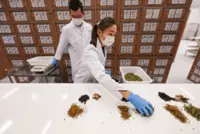Diners toss yu shang at a Chinese New Year feast. Photo: South China Morning Post
Until recently, when Hongkongers talked about “yu sang” (“raw fish”), they would have meant the Japanese interpretation – sashimi. But these days, around Lunar New Year, the term is also used to refer to the festive Singaporean dish that also goes by the names yu sheng, lo hei and prosperity toss.
In Singapore, yu sheng (yee sang in Malaysia) is a festive salad of sorts – a large platter of colourful, finely cut or grated ingredients, such as carrot, cucumber, white radish, pickle and, of course, raw fish, along with an array of condiments such as sesame oil, plum sauce, crushed peanuts, crisp deep-fried wonton skins, pepper and cinnamon.





